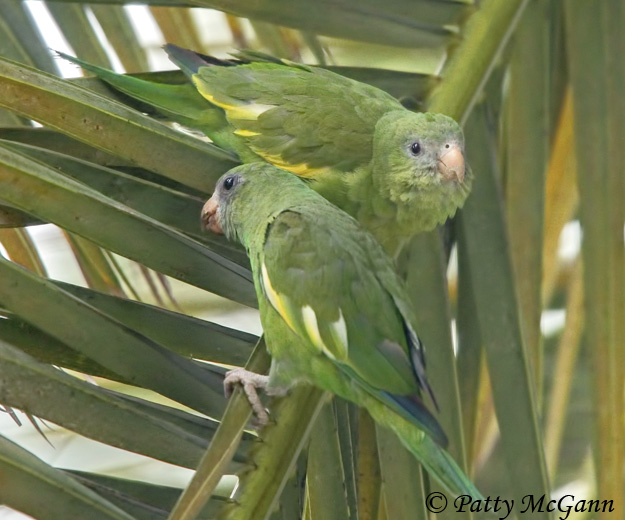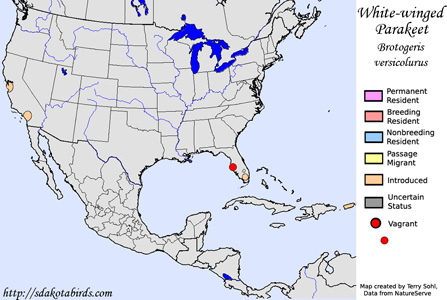| Length: 8-10 inches | Wingspan: 13-14.5 inches | Seasonality: Non-resident in South Dakota |
| ID Keys: Green overall, white wing patch obvious in flight, yellow leading edge on folded wing | ||
 The
White-winged Parakeet is a medium-sized parakeet native to portions of South
America. The trademark white wing is a characteristic that's typically only
seen in flight, when a large white wing patch is easily seen. At rest,
the wing shows a band of yellow, and as such, the species is also sometimes
called the "Canary-winged Parakeet". They have been a popular caged
bird, and escapees have managed to established permanent breeding
populations in several locations in the United States. Los Angeles, San
Francisco, and Miami are the three locations where they are often seen.
They were once more common in these cities, particularly in the 1960s and
1970s, but populations have declined in the last few decades.
The
White-winged Parakeet is a medium-sized parakeet native to portions of South
America. The trademark white wing is a characteristic that's typically only
seen in flight, when a large white wing patch is easily seen. At rest,
the wing shows a band of yellow, and as such, the species is also sometimes
called the "Canary-winged Parakeet". They have been a popular caged
bird, and escapees have managed to established permanent breeding
populations in several locations in the United States. Los Angeles, San
Francisco, and Miami are the three locations where they are often seen.
They were once more common in these cities, particularly in the 1960s and
1970s, but populations have declined in the last few decades.
Habitat: For introduced birds in the United States, they are primarily found in suburban and urban settings, in areas with extensive landscape and tropical vegetation. In their native range, they are mostly found in second-growth or otherwise disturbed forest, or around forest edges and clearings.
Diet: Feeds on a variety of food items, including fruits and berries, seeds, nuts, flower blossoms and nectar, and fresh shoots and buds.
Behavior: Foraging is primarily done in the forest canopy, although if food sources are closer to the ground, they will feed there. They are gregarious birds outside of the breeding season, forming large communal flocks.
Nesting: The nest is a cavity of a tree, with no additional augmentation or lining. The female lays 3 to 5 eggs, and she alone incubates them. The male typically will bring food to the nest cavity during the incubation period. The eggs hatch after about 25 days, and both parents help to feed and protect them. The young fledge from the next after about six weeks after hatching.
Song: Like many parrots and parakeets, they have a very wide range of vocalizations. They will often give a raucous shrieking call, as well as
Migration: Considered non-migratory throughout its normal range.
Feeders: For populations established in the U.S., they will sometimes attend feeders for offered fruit, nuts, and seeds.
Interactive eBird map: Click here to access an interactive eBird map of White-winged Parakeet sightings
Similar Species: In Florida, introduced Yellow-chevroned Parakeets are sometimes seen, and are similar in appearance to White-winged Parakeets. Those two species were once considered one species before they were split.
Conservation Status: White-winged Parakeets are considered common in parts of their range in South America. Their overall population may be decreasing, but they are still considered a species of "Least Concern" by the IUCN.
Further Information: 1) WhatBird - White-winged Parakeet
2) Oiseaux.com - Canary-winged Parakeet
3) Cornell's NeoTropical Birds - White-winged Parakeet
Photo Information: Photo by Patty McGann - Photo licensed under Creative Commons Attribution NonCommercial 2.0 Generic License -
| Click below for a higher-resolution map |
 |
| South Dakota Status: Non-resident in South Dakota |
Additional Zone-tailed Hawk Photos (coming soon!!)
